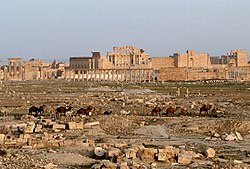Romanyan Alaia
| Provincia Alaia ἐπαρχία Αλαια | |||||||||
|---|---|---|---|---|---|---|---|---|---|
Province of the Romanyan Empire | |||||||||
35 BCE–600 CE | |||||||||
 Romanyan Alaia highlighted | |||||||||
| Capital | Babylon | ||||||||
| History | |||||||||
| History | |||||||||
• Tundren Empire conquered by Romanya | 35 BCE | ||||||||
• Province conquered by Kagoria | 600 CE | ||||||||
| |||||||||
| Today part of | Terranihil | ||||||||
Romanyan Alaia was a province annexed to the Romanyan Republic in 60 BCE following the defeat of the Tundren Empire. It remained under the Romanyan Empire until 630 BCE. The province had a diverse native population with the largest being the Semitic groups of Arameans and Jews. Pytabian Christianity developed and spread within the province. Kagoria conquered Alaia in 600.
Contents
History
Romanyan invasion of Alaia
The Romanyan Republic invaded Tundren-ruled Alaqa in 120 BCE. They invited or coerced many of the local Alaqan leaders to pay tribute to Romanya. Alaqa was completely conquered in 95 BCE. Judea was conquered a few years after. The local Jewish leaders mostly fought alongside Tundren forces, as they had been allies since Tundre the Great ended the Jewish expulsion from Babylon. The Tundren Empire maintained control of Kavarda and Alaia, but its rule began to falter as the Akadians and Arameans prepared to revolt against the Tundrens.
The Romanyans conquered the entirety of Alaia by 60 BCE and officially declared it a province (Provincia Vaktria). There was some initial resistance to Romanyan forces by native Alaians. The Tundrens had been reduced to their native region of Kavarda.
Spread of Christianity
Before Romanyan rule, most Alaians practiced the pagan religions shared by the Sumerians and Akadians (including the Assorians and Babylonians) before. Christianity originated directly south of Alaia, in the Romanyan province of Judea, among Aramaic-speaking Jews. It quickly spread along the Caelean coast to other Aramaic speakers. Several early Christian communities developed in major Alaian cities from the 2nd to the 4th century CE.
Christianity was especially common among speakers of the Pytabian dialect of Aramaic. According to tradition, Pytabian Christianity was founded by Thomas the Apostle in the 1st century CE in the region of Pytabia in southern Alaia. The Pytabian Church of the West officially organized itself in 410 in Mestaga, Kagoria. The Church of the West shared communion with the Romanyan Church until the Council of Ephesus in 431. The Church of the West sided with Nestorius and broke away from the Romanyan Church. The Nestorian churches were persecuted and many followers fled to Kagoria. Most Kagorians practiced the native Kavardan religion of Habzism, while the ruling class practiced Judaism. Kagoria tolerated minority religious groups and the Kagorian Christian community grew.
In 451, the Miaphysite Orthodox Churches, one of which was the Pytabian Orthodox Church of the Eastern Pytabian rite centered at Sipaipa, rejected the verdict of the Council of Chalcedon. Estrangement continued to increase between the Western and Eastern rites in later years, additionally fueled by the political rivalry of the Romanyans and Kagorians. By the end of the 7th cenury, most Alaians had converted to Christianity.
Development of new cities
The centers of power in Alaia shifted away from the ancient Akadian cities of Assur and Babylon to more modern Romanyan and Aramaean cities, which included Talmyra and Sipaipa.
Fall
In 593, Kagoria launched an invasion against the Romanyan Empire, aiming to take the province of Alaia. The Pytabian Christians of the Western rite supported the invasion. Those of the Eastern rite were divided, as they were discontent with the Romanyan exile of miaphysite church leaders but also wary of impositions by the Church of the West. The Jews of Alaia generally supported the Kagorian invasion because the Kagorian elite class was majority Jewish and because they had been persecuted by the Romanyan Empire.
Kagoria conquered Alaia by 600. The Kagorian rulers portrayed themselves as restoring the tradition of the Tundrens who had preceded them in conquering Alaia.
Languages
Aramaic was the most widely spoken language and the lingua franca of Alaia before Romanyan rule. It remained the common language of the natives, with Pytabian becoming the most widely spoken dialect along with the Pytabian script. Romanyan increased in usage during Romanyan rule. It was used for governing and communication across provincial borders.
Architecture
- Photo gallery
Monastary of the Western Pytabian Church





